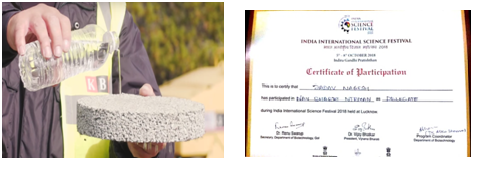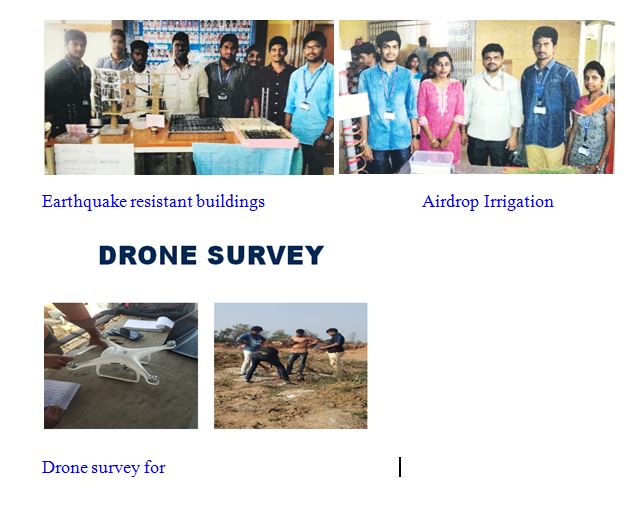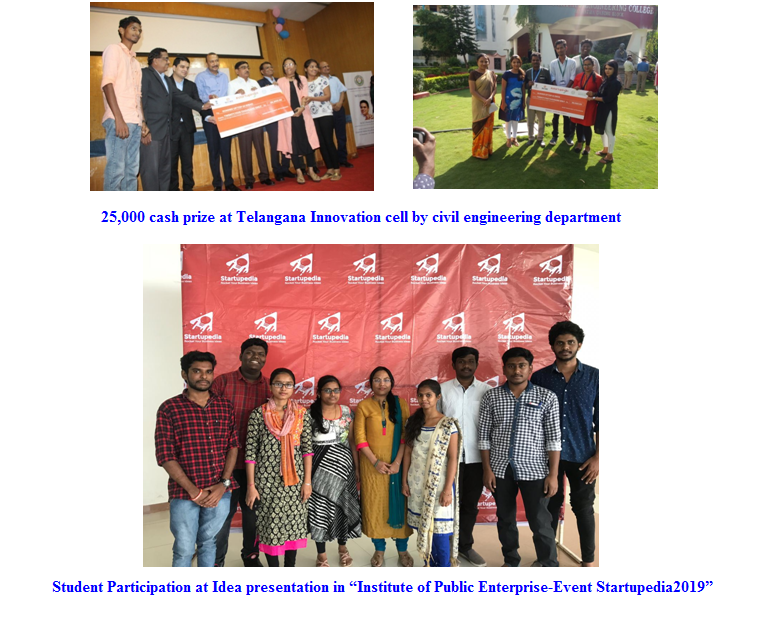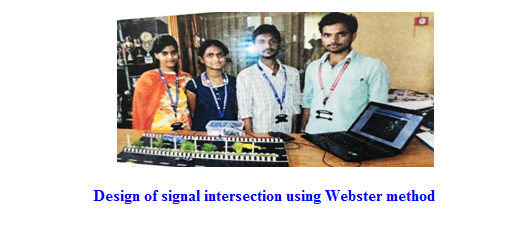Objectives of the Clubs:.
Faculty coordinators are dedicated towards building awareness of technology and promote applications, as well as the versatility in all areas of civil engineering viz..Concrete technology, Geotechnical engineering, Environment engineering, Traffic engineering, Sustainable development, Entrepreneurship groups accessible as “civil engineering clubs” for students with an opportunity to gain hands-on, practical experience and leadership skills .
1. Concrete Club
Endows the students to learn, and acquire skills by working with concrete mix designs and to perform analysis to build strong structures and exhibit through model expo’s.
2. Club for a Sustainable Development
Club affirms affordable, reliable, sustainable and modern energy for all. Ensures access to promoting sustained, inclusive and sustainable development by building resilient infrastructure, uphold inclusive and sustainable industrialization and foster innovation.
3. Geotech Club
Is well-designed club nurturing research around soils bearing capacity and other parameters aligned with soil studies.
4. ENVI Protection Club
Infuses intricate thinking in the minds of students and polarizing thoughts into the process and thereby drawing solutions to environmental problems dealing with drinking water quality, safe waste water disposal, and groundwater improvement.
5. Civil Engineering Club for Startups
The clubs motive is to help students in realizing the entrepreneur ideas, to innovation by pragmatic approach
6. Transportation Club of SMEC
Club’s objectives is to cultivate closer relations between those directly interested in highway and transportation; to promote programs and to encourage the study and discussion of transportation subjects and interchange of thoughts ideas thereon between members; to inspire to construct and find solutions in traffic work.
Concrete Canoe Club Activity:
For the unique project using waste plastic for the purpose of recycling and production of construction bricks, Aakaar is now Asia's largest civil engineering fest; it is the international level project. Aakaar has been working as a great platform for the students across the country to showcase and enhance their skills at the highest level. St Martin’s engineering college was recognized as a national and as well as international level project award winner.
The project made by the plastic bottles which are collected from our SMEC.
In this project we can use waste plastic and Robo sand. Then the Fine Aggregate has been introduced gradually into this molten plastic, in the ratio of 3:1 (Plastic : FA). Finally, this mixture was transferred into the oiled Rhombus shaped moulds of 10 x 10 x 5cm and left it to solidify for a period of 2 hours, and then we could end up with our Plastic Paving Blocks.

We can use this blocks in Parking, Foot path,Petrol bunks
Project Title : Water Absorption Roads
Water Absorbing pavement is a new technique in Pavement construction. Through this technique we can find a solution for the low ground water level, effective management of storm water runoff, Agricultural problems, etc. Pervious concrete can be introduced in low traffic volume areas, walk ways, sub base for concrete pavements, inter locking material etc. Pervious concrete as a paving material have the ability to allow water to flow through itself to recharge ground water level and minimize surface storm water runoff. This property of porous concrete reviews its applications and engineering properties, including environmental benefits, strength and durability. By replacing a part of cement with flash, then it results the safe disposal of waste material. Hence it acts as an eco-friendly paving material.

The same project was exhibited at:The 1st IISF India International Science Festival was held at Indian Institute of Technology Lacknow in October
A Mechanical Study on Self Compacting Concrete Using Nano Silica
addition of Nano-silica to concrete as partial replacement to cement in dosages of 1%, 1.5% and 2% by weight of cement. Based on early research M25 grade concrete has been chosen for this work. The mix design was prepared using IS: 10262-2009 Guidelines for concrete mix design proportioning. In the present work 24 numbers of cube moulds and 12 numbers of cylinder moulds were casted with addition of Nano-silica with different proportions which are tested for compressive strength and split tensile strength. Addition of Nano-silica to normal cement concrete show increase in compressive strength and decrease in splitting tensile strength. The compressive strength of cement concrete can be increased considerably by the addition of Nano-silica. Based on the experimental results, use of Nano-Silica as partial replacement of cement in small quantities is advantageous on the performance of concrete. Nano-Silica added in small quantities can improve the compressive strength. The increase in various strength characteristics of concrete containing nano-silica content can be due to the availability of additional binder in the presence of nano-silica. Nano silica has high amorphous silicon dioxide content. The Portland cement in concrete releases calcium hydroxide during the hydration process. The nano silica reacts with the calcium hydroxide to form additional binder material. The availability of additional binder leads to increase in the paste-aggregate bond, results improved strength properties of the concrete prepared with nano-silica combination.
Club for a Sustainable Development:

Geotech Club.
Stabilization of Black Cotton soils using bituminuous emulsion
Soil stabilization can be explained as the alteration of the soil properties by chemical or physical sustain the load of the superstructure especially in case of soil which are highly active, also it saves a lot of time and millions of money when compared to the method of cutting out means in order to enhance the engineering quality of the soil. The main objective of the soil stabilization to increase the bearing capacity of the soil, its resistance to weathering process and soil permeability. the long-term performance of any construction project depends on the soundness of the underlying soils. Unstable soil can create significant problems for pavements or structures, therefore soil stabilization techniques are necessary to ensure thegood stability of soil so that it can successfully and replacing the unstable soil, these bituminous emulsion transforms unstable soils into stable soils. The use of bituminous stabilization agents is somewhat less common, but worthy of consideration, working with bituminous required close attention to application rate. Both anionic and cationic emulsion show compatibility with cold, moist materials, break and curing are important for desirable mix performance. For stabilization of deeper layers, cationic emulsion is preferred. Bitumen emulsion ss2 is especially designed water based emulsion with low application. It is chocolate brown color and is free flowing liquid at ambient temperature. It is good in penetration into miniature pores of sub bases, penetrate the cracks & crevices and impart strength to the layers, low temperature curing, high adhesive properties, prevent permeability of atmosphere air to the bottom layer, binds loose aggregate together strongly, prevents lateral movement of structural layers, water resistant and enhance easy drainage of water. This project mainly focused on how the properties of soil like angle of internal friction, cohesion, OMC, MDD, CBR values changes upon reinforcing the soil by bituminous emulsion ss2 at various percentages. It is simplest method of soil stabilization. The use of bituminous emulsion to stabilization the soil becomes more stable be reduction in the permeability and compressibility and by the increase in the shear strength. With the increase in these properties the bearing capacity of the soil is increased slightly.
Study on Black cotton soils using terrazyme in kompally village
Stabilization of black cotton soil (B C) is studied by using terrazyme BC soils are highly clayey soils (montmorillonite clay mineral). The moisture change in BC soils, compressibility and last- plasticity nature can be greatly improved with the addition of terrazyme .this paper includes the evaluation of soil properties like optimum moisture content, dry density and strength parameter(California bearing ratio valve). Different quantities of terrazyme (% weight) are added to the BC soil and the experiments conducted on these soils mixes. The results show that the use of teraenzyme increases the California bearing ratio valves i.e the strength of soil to a great extent.
ENVI Protection Club.
Removal of Turbidity by Low Cost Adsorbents

Usage of natural products to reduce turbidity in a water sample is a technique that has been repeated from years, and the material used are safe and effective, like Rice husk, Ground-nut shells and Vetiver root. These materials can reduce the level of turbidity in the best way as it can (more than 60%). The materials are generally named as Bio-adsorbent which can remove turbidity from any sort of water sample.
The turbidity removal efficiency of groundnut shell powder (76.66%) was high when compared to rice husk powder (72.93%) and vetiver root powder (73.55%). These natural adsorbents can be effectively used for turbidity without giving any chemical treatment for adsorbents.
Civil Engineering Club for Startups.

Transportation Club of SMEC







